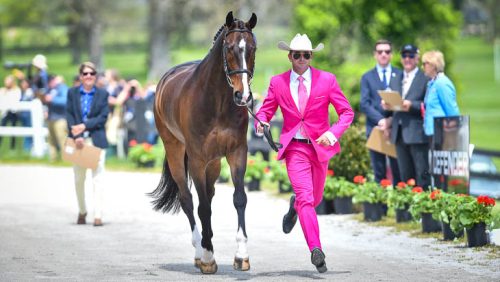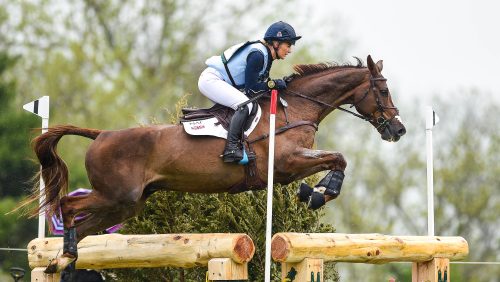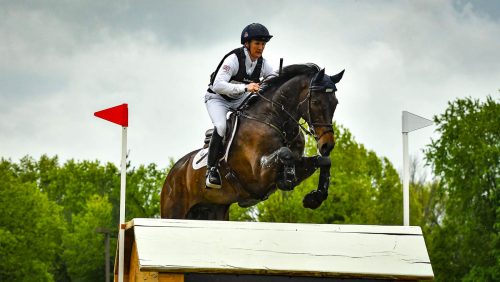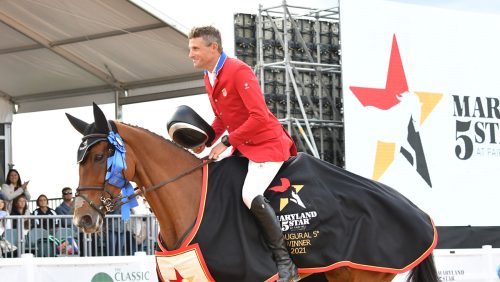It’s been 10 years since Gina Miles and McKinlaigh took their victory lap around the Olympic stadium in Hong Kong, Miles wearing her individual silver medal while brandishing a bouquet of red roses and her megawatt smile. McKinlaigh has long since retired, but Miles is still competing at the top levels of eventing, developing several horses to the advanced level and taking SVR Ron to the Rolex Kentucky CCI**** in 2015.
Miles considers herself lucky to have developed a network of friends and supporters who have helped her acquire mounts with upper-level potential, including Greenfort Othello, owned by the Greenfort Othello Syndicate. Miles and “Othello” won the Galway Downs CIC**, held March 29-April 1 in Temecula, Calif.
Miles first met the 13-year-old Irish Sport Horse gelding (Radolin—Sevarine, Mon Tresor) nearly two years ago. “He is like a Labrador retriever,” said Miles. “He is the sweetest, most gentle soul.”
The Chronicle caught up with Miles to talk more about her new equine partner, the perpetual challenge of balancing motherhood with equine aspirations, and of course, her future Olympic plans.
COTH: Tell us a bit about Greenfort Othello.
Miles: This horse was bought by an adult amateur, who imported him from Greenfort Farm in Ireland about four years ago. After she bought him, a lot of things changed in her life, and she wasn’t able to do anything with him, so he sat for a while. A few years ago, I had been showing at [HITS Thermal (California)] and got to know Hope Glynn, who knew Tara [Verkuil, Othello’s former owner]. Hope suggested that I try him out. He had a lateral walk and a four-beat canter, and he was huge. He is 17-plus hands and just big. I’m not that tall, and I really like a good 16-hand horse. But since I rode McKinlaigh, everyone thinks I like big horses!
COTH: So you weren’t drawn to him at first?
Miles: I thought he was too big, and he had that lateral walk. But I really liked his jump. I talked to Tara about it, and we decided that maybe I should just ride him for a month to see what we could do and where we could get to. Othello had intermediate experience in Ireland, but it had been a few years. To find a horse that you can enter advanced who can really do the jumps, when you haven’t taken a trip around advanced in a few years, is a big deal. We agreed that I would take him over at my expense, I would work with him, and then we would try to sell him. What I quickly learned was that he has an amazing work ethic—that is what McKinlaigh had. If you can’t train them, it doesn’t matter how talented they are. It helps so much when you have a willing partner, and that is what really made me want to stick with him. Tara really cared about him and wanted him to end up with me, so she was wonderful to wait and work with us while we made the arrangements to try to purchase him, which finally all came together about six weeks ago.
COTH: What has been your focus in his training?
ADVERTISEMENT
Miles: He was super unfit when I started, because he had been standing around for a while. And for the Irish, [despite] all of the other wonderful things they teach their horses, developing the dressage is just not a priority. We had to do a lot of work to correct his muscling. I first competed him late spring of 2016 at preliminary, and we finished that year at the one-star at Galway. In 2017, we went all the way through the CCI** at Rebecca Farm [Montana], and then we went to move up to advanced in the fall [at Twin Rivers in California]. He struggled in the show jumping, not because of a lack of scope but because his shape was all over the place. Half the course he would jump beautifully, then the other half it was like bowling for rails. It was like he had forgotten where all of his body parts were.
COTH: What was your strategy for improving that?
Miles: Improving the flatwork was a huge foundation. I work with Sandy Phillips, and I had some seriously painful dressage lessons with him, some where we only walked. Teaching a horse to move more correctly and use their body correctly is a long process. I also got a lot of help from David O’Connor, and we tried to help him learn to use his body properly by choosing fences and exercises that rewarded him for using the right shape. Some training approaches punish them for using the wrong shape, but we instead chose to take a positive approach and reward him for using the right one. We did a lot of gymnastics this winter—grids, bounces, combinations, guide rails and placing rails. It has also helped that he has a year and a half of more correct muscling as well.

David O’Connor helped Gina Miles sort out Greenfort Othello’s dressage. Photo courtesy of Gina Miles.
COTH: In your ideal world, if you’re choosing a horse to train for the upper levels of eventing, what do you look for?
Miles: It is like finding a unicorn! I was just in Europe in November looking for horses for some clients, and I looked at 200 horses. It is frustrating. To be competitive in today’s sport, they must move well and have a good disposition. They must be careful and scopey for show jumping, but not so careful that they lose the bravery for cross-country. When I’m evaluating a horse, I have to ask myself if they can have the right mix of being careful and being brave. It is the horse’s disposition that brings it all together. I looked at some horses that were talented and flashy, but they also looked like they would be nappy or argumentative. Trainability is so important. Do they enjoy being a partner? Some just don’t, and it is harder to turn those into an eventer than a show jumper.
COTH: What is your ideal age range to start horses in your program?
Miles: I do like starting them as youngsters. That partnership that you develop when they are 4 or 5, and you know everything about them, is hard to replace. I started McKinlaigh when he was 5. I have two 5-year-olds from Ireland in the barn now.
COTH: You’ve made a deliberate choice to keep your program small. Why does that work for you?
Miles: Six is my ideal number of horses. I can really manage that number on my own. If you are keeping 15 to 20 in your program, you are not the one schooling them every day and knowing everything about them. I have hit the goal of being at the Olympics, and so once I did that, I came to the realization that there was something even more important to me, and that is the partnership I have with my horses and seeing them progress and develop.
ADVERTISEMENT
COTH: So, you aren’t thinking about the Olympics anymore?
Miles: (laughs) Of course, the goal is always getting back to the Olympics! But after I came home from the 2008 Olympics, and you have time to stop and think about it, you realize that it is a huge push to get there. It is really intense, and there are so many sacrifices you have to make. So you get back and say, “Do I really want to do that again?” When Los Angeles made the bid for the 2028 Games, it inspired me to aim for that goal again—I got into this sport after watching the 1984 Olympics in Los Angeles, and I just really want to ride in the Olympics there. I started to think about what needs to happen or change for me in order to make a big run for [an Olympic team]. And the way I see it, this may be my final chance. I am 44 now, and I don’t think I really need to be jumping around four-star tracks when I’m in my mid-50s.
COTH: You’ve always made it clear that your family is a priority for you along with your riding. How have you found that balance?
Miles: (laughs again) At the Pony Club convention this year, they asked me to give a talk on balancing competing, training and motherhood. I told them that I hadn’t figured it out yet! Mostly I’ve learned that you have to prioritize. Before I had kids I would never have left the barn with a piece of dirty tack. But sometimes you have to get home in time for the theater performance or choir practice, and that tack will still be dirty in the morning. I wouldn’t say that I have lowered my standards, but it puts things in perspective. My daughter Taylor is now 12, and she’s competing at novice on Philippa, whom I bought in Germany as a 5-year-old and developed through advanced. We sold her to the jumper ring, but now she is back with us. So that has been really fun, not just to be out together but to have her on my old advanced horse. My son Austin is 19. He is not super horsey, but he rides well enough that if we are all going to ride horses on the beach and gallop around, he can have a fun time with us as a family.

Taylor Miles shares her mother’s love of horses and is now competing Gina’s old advanced horse Philippa. Photo courtesy of Gina Miles.
COTH: How have you balanced high level equestrian sport with your personal relationships?
Miles: My ex-husband [Morgan Miles] and I were together for 25 years. We were high school sweethearts, and he was always really involved with the horses and helping me. We did all of the international travel together, and he was a tremendously supportive spouse, as was his family. We balanced all of that really well, as a team. Our divorce is totally amicable; people sometimes just grow apart and want to do different things with their lives. He is still a good support with Taylor competing now and still a part of our overall team. I am now with James Johnson, who is a former bull rider and jouster. He also has two kids, who are getting involved with horses, and James is interested in eventing. So we are continuing with the tradition of a whole family that participates in riding. It is great to have a person who is so supportive, who can help drive the horse trailer and is comfortable in the barn. I thought at first that I didn’t want to date someone who was into horses, but now I know I wouldn’t have it any other way.
COTH: Has your connection to horses helped you navigate through all of this personal change?
Miles: Through all of the challenging things in my horsey life, my family has always grounded me. To be able to leave the barn and go home at night and do normal things is important. Even during the years I was competing internationally, or at the Olympics, giving the children a bath in the hotel room, something so normal, kept me grounded. I think the reverse is true, too; when you have lots of changes in your human life, the horses ground you. The last three years have had a lot of change for me; the barn I was at in San Luis sold, I was in the early stages of being separated, and it was clear that I would be relocating. Change can be scary or it can be positive. If you can learn to embrace it and go with it, it can lead to new opportunities and new directions. I have chosen to let it be positive.
COTH: You’ve recently moved?
Miles: After 20 years in the San Luis Obispo area, we made the move to the East Bay area, about 45 minutes inland from San Francisco. It is a great equestrian area; there are lots of horses and hills. There are many more clients in this area, and to make a serious bid for the Olympics, it’s a better area to base out of to push for that goal.















